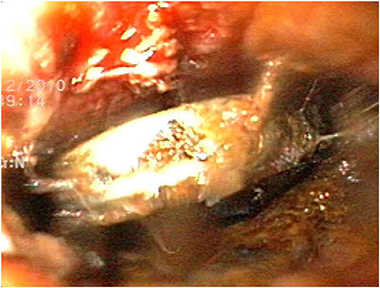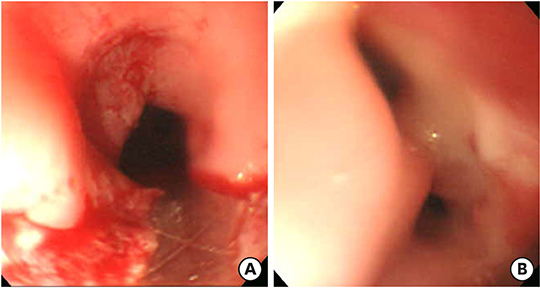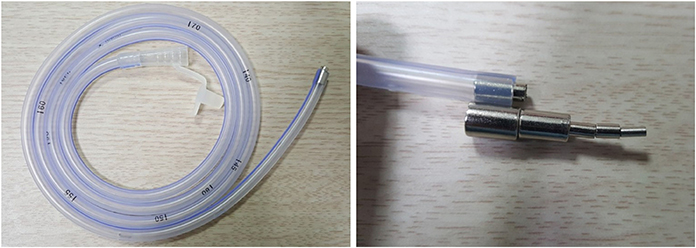Pediatr Gastroenterol Hepatol Nutr.
2019 Mar;22(2):132-141. 10.5223/pghn.2019.22.2.132.
Foreign Body Removal in Children Using Foley Catheter or Magnet Tube from Gastrointestinal Tract
- Affiliations
-
- 1Department of Emergency Medicine, School of Medicine, Kyungpook National University, Daegu, Korea.
- 2Department of Pediatrics, School of Medicine, Kyungpook National University, Daegu, Korea. bhchoe@knu.ac.kr
- KMID: 2440587
- DOI: http://doi.org/10.5223/pghn.2019.22.2.132
Abstract
- Foreign body (FB) ingestion of children is a common pediatric emergency requiring medical attention. Pediatric emergency physicians and gastroenterologists often encounter nervous and distressed situations, because of children presenting with this condition in the common clinical practice. When determining the appropriate timing and indications for intervention, physicians should consider multiple patient- and FB-related factors. The utilization of a flexible endoscopy is considered safe and effective to use in these cases, with a high success rate, for the effective extraction of FBs from the gastrointestinal tract of a child. Additionally, a Foley catheter and a magnet-attached Levin tube have been used for decades in the case of FB removal. Although their use has decreased significantly in recent times, these instruments continue to be used for several indications. Using a Foley catheter for this purpose does not require special training and does not necessarily require sedation of the patient or fluoroscopy, which serve as advantages of utilizing this method for foreign object retrieval. An ingested magnet or iron-containing FB can be retrieved using a magnet-attached tube, and can be effective to retrieve an object from any section of the upper gastrointestinal tract that can be reached. Simple and inexpensive devices such as Foley catheters and magnet-attached tubes can be used in emergencies such as with the esophageal impaction of disk batteries if endoscopy cannot be performed immediately (e.g., in rural areas and/or in patients presenting at midnight in a facility, especially in those without access to endoscopes or emergency services, or in any situation that warrants urgent removal of a foreign object).
Keyword
MeSH Terms
Figure
Cited by 1 articles
-
Safety and Competency are the Main Priorities in Pediatric Endoscopy
Byung-Ho Choe
Clin Endosc. 2020;53(4):379-380. doi: 10.5946/ce.2020.124.
Reference
-
1. Seo JK, Choe BH. Endoscopic removal of gastrointestinal foreign bodies in 3 newborn infants immediately after birth. Korean J Gastrointest Endosc. 1998; 18:87–91.2. Choe BH, Park GS, Hwang JB. Endoscopic removal of foreign bodies from the upper gastrointestinal tract in children: management of 78 cases in Taegu, Korea. Korean J Gastrointest Endosc. 2000; 20:6–13.3. Gummin DD, Mowry JB, Spyker DA, Brooks DE, Fraser MO, Banner W. 2016 Annual Report of the American Association of Poison Control Centers' National Poison Data System (NPDS): 34th annual report. Clin Toxicol (Phila). 2017; 55:1072–1252.
Article4. Choe BH, Nho US. Rescue of child with accidental overingestion of iron tablets by gastroscope. Korean J Gastrointest Endosc. 1997; 17:801–805.5. Tringali A, Thomson M, Dumonceau JM, Tavares M, Tabbers MM, Furlano R, et al. Pediatric gastrointestinal endoscopy: European Society of Gastrointestinal Endoscopy (ESGE) and European Society for Paediatric Gastroenterology Hepatology and Nutrition (ESPGHAN) Guideline executive summary. Endoscopy. 2017; 49:83–91.
Article6. Kim JO, Hong EH, Choe BH, Cho MH, Seo HE, Lim HR, et al. Comparison of endoscopic removal of disk batteries in children. Korean J Pediatr Gastroenterol Nutr. 2007; 10:147–156.
Article7. Seo JK. Endoscopic management of gastrointestinal foreign bodies in children: a clinical practice guideline. Korean J Pediatr Gastroenterol Nutr. 2007; 10:64–69.8. Kang JH, Jung HJ, Suh JK, Park JS, Park HJ, Chu MA, et al. Feasibility of foley catheter prior to endoscopy for the removal of esophageal coin in children. Korean J Pediatr Gastroenterol Nutr. 2011; 14:251–257.
Article9. Joyamaha D, Conners GP. Managing pediatric foreign body ingestions. Mo Med. 2015; 112:181–186.10. Conners GP, Chamberlain JM, Ochsenschlager DW. Foley catheter and esophageal foreign bodies. Pediatrics. 1995; 96:791.
Article11. Lee JH, Lee JH, Shim JO, Lee JH, Eun BL, Yoo KH. Foreign body ingestion in children: should button batteries in the stomach be urgently removed? Pediatr Gastroenterol Hepatol Nutr. 2016; 19:20–28.
Article12. Kramer RE, Lerner DG, Lin T, Manfredi M, Shah M, Stephen TC, et al. Management of ingested foreign bodies in children: a clinical report of the NASPGHAN Endoscopy Committee. J Pediatr Gastroenterol Nutr. 2015; 60:562–574.13. Magalhães-Costa P, Carvalho L, Rodrigues JP, Túlio MA, Marques S, Carmo J, et al. Endoscopic management of foreign bodies in the upper gastrointestinal tract: an evidence-based review article. GE Port J Gastroenterol. 2015; 23:142–152.
Article14. Bigler FC. The use of a Foley catheter for removal of blunt foreign bodies from the esophagus. J Thorac Cardiovasc Surg. 1966; 51:759–760.
Article15. Macpherson RI, Hill JG, Othersen HB, Tagge EP, Smith CD. Esophageal foreign bodies in children: diagnosis, treatment, and complications. AJR Am J Roentgenol. 1996; 166:919–924.
Article16. Agarwala S, Bhatnagar V, Mitra DK. Coins can be safely removed from the esophagus by Foley's catheter without fluoroscopic control. Indian Pediatr. 1996; 33:109–111.17. Little DC, Shah SR, St Peter SD, Calkins CM, Morrow SE, Murphy JP, et al. Esophageal foreign bodies in the pediatric population: our first 500 cases. J Pediatr Surg. 2006; 41:914–918.
Article18. Mariani PJ, Wagner DK. Foley catheter extraction of blunt esophageal foreign bodies. J Emerg Med. 1986; 4:301–306.
Article19. Stack LB, Munter DW. Foreign bodies in the gastrointestinal tract. Emerg Med Clin North Am. 1996; 14:493–521.
Article20. Conners GP. A literature-based comparison of three methods of pediatric esophageal coin removal. Pediatr Emerg Care. 1997; 13:154–157.
Article21. Schunk JE, Harrison AM, Corneli HM, Nixon GW. Fluoroscopic foley catheter removal of esophageal foreign bodies in children: experience with 415 episodes. Pediatrics. 1994; 94:709–714.
Article22. Towbin R, Lederman HM, Dunbar JS, Ball WS, Strife JL. Esophageal edema as a predictor of unsuccessful balloon extraction of esophageal foreign body. Pediatr Radiol. 1989; 19:359–360.
Article23. McGuirt WF. Use of Foley catheter for removal of esophageal foreign bodies. A survey. Ann Otol Rhinol Laryngol. 1982; 91:599–601.
Article24. Equen M. A new magnet for foreign bodies in the food and air passages. JAMA. 1945; 127:87–88.
Article25. Silber S, Epstein BS. The peroral removal of certain swallowed foreign bodies without endoscopy; introducing a new device utilizing the alnico magnet. N Y State J Med. 1947; 47:1122–1124.26. Kuhns DW, Dire DJ. Button battery ingestions. Ann Emerg Med. 1989; 18:293–300.
Article27. McDermott VG, Taylor T, Wyatt JP, MacKenzie S, Hendry GM. Orogastric magnet removal of ingested disc batteries. J Pediatr Surg. 1995; 30:29–32.
Article28. Volle E, Beyer P, Kaufmann HJ. Therapeutic approach to ingested button-type batteries. Magnetic removal of ingested button-type batteries. Pediatr Radiol. 1989; 19:114–118.
Article29. Mowry JB, Spyker DA, Brooks DE, McMillan N, Schauben JL. 2014 Annual Report of the American Association of Poison Control Centers' National Poison Data System (NPDS): 32nd annual report. Clin Toxicol (Phila). 2015; 53:962–1147.
Article30. Talvard M, Mouttalib S, Flaum V, Viala J, Galinier P, Olives JP, et al. Magnet ingestions in children: a French multicenter study. Arch Pediatr. 2015; 22:32–38.31. Waters AM, Teitelbaum DH, Thorne V, Bousvaros A, Noel RA, Beierle EA. Surgical management and morbidity of pediatric magnet ingestions. J Surg Res. 2015; 199:137–140.
Article32. Agbo C, Lee L, Chiang V, Landscahft A, Kimia T, Monuteaux MC, et al. Magnet-related injury rates in children: a single hospital experience. J Pediatr Gastroenterol Nutr. 2013; 57:14–17.33. Strickland M, Rosenfield D, Fecteau A. Magnetic foreign body injuries: a large pediatric hospital experience. J Pediatr. 2014; 165:332–335.
Article34. Arana A, Hauser B, Hachimi-Idrissi S, Vandenplas Y. Management of ingested foreign bodies in childhood and review of the literature. Eur J Pediatr. 2001; 160:468–472.
Article35. Volle E, Beyer P, Kaufmann HJ, Hanel D. Removal of swallowed metallic foreign bodies by orogastric magnetic intubation. Z Kinderchir. 1987; 42:346–349.36. Volle E, Hanel D, Beyer P, Kaufmann HJ. Ingested foreign bodies: removal by magnet. Radiology. 1986; 160:407–409.
Article37. Kim MK, Kim SW, Sungwoo JC, Park HS. Clinical evaluation of foley catheter technique for removal of blunt esophageal foreign bodies. Korean J Otolaryngol-Head Neck Surg. 1985; 28:793–795.38. Ham PB 3rd, Ellis MA, Simmerman EL, Walsh NJ, Lalani A, Young M, et al. Analysis of 334 cases of pediatric esophageal foreign body removal suggests that traditional methods have similar outcomes whereas a magnetic tip orogastric tube appears to be an effective, efficient, and safe technique for disc battery removal. Am Surg. 2018; 84:1152–1158.
Article39. Kim GW, Kim SY, Lee CC, Kim C, Jung YS. Removal of esophageal blunt foreign bodies by using a foley balloon catheter in the emergency department. J Korean Soc Emerg Med. 2001; 12:359–368.40. Dokler ML, Bradshaw J, Mollitt DL, Tepas JJ 3rd. Selective management of pediatric esophageal foreign bodies. Am Surg. 1995; 61:132–134.
- Full Text Links
- Actions
-
Cited
- CITED
-
- Close
- Share
- Similar articles
-
- Gastrointestinal Foreign Bodies in Children: Experiences of 60 Cases in Kangwon, Korea
- Value of modified foley catheter method in the removal of blunt esophageal foreign bodies
- Removal of esophageal foreign body using Foley catheter under fluoroscopic guide
- Underestimated risks of rare-earth magnet ingestion in children: when does it need surgery?
- A Case of Ingested Two Magnets Attracted Each Other that were Holding Gastric Mucosa




